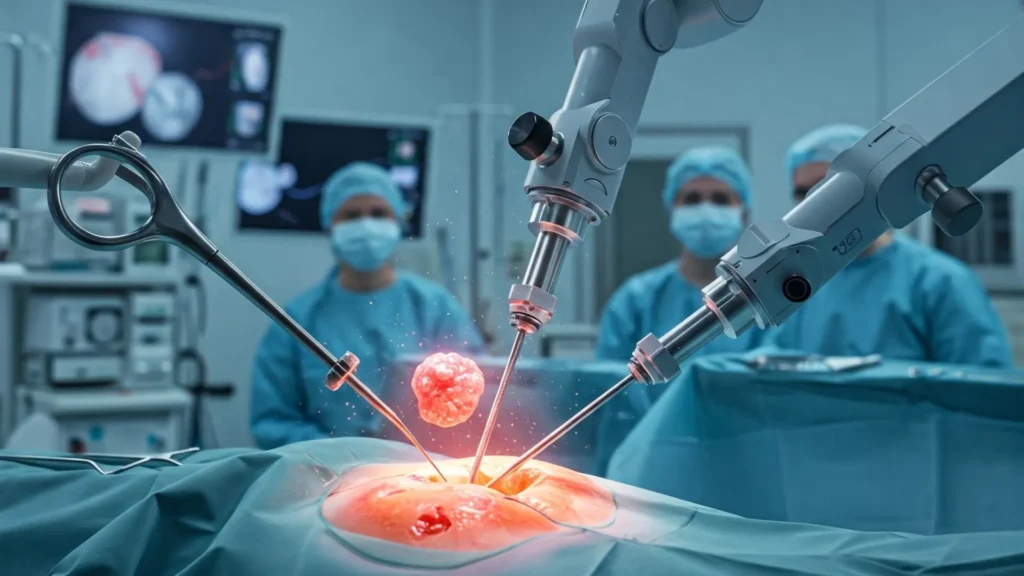In a rare medical success, Indian surgeons have managed to successfully excise the world’s largest adrenal tumor with the help of superior robotic surgery. This milestone not only showcases India’s emerging leadership in the domain of robotic healthcare but also brings on new possibilities for future treatments across the globe.
The patient, a 39-year-old man with an unusually large adrenal tumor, had experienced severe discomfort, hypertension, and serious health complications. Open surgery was too risky, but the pioneering application of robotic technology reversed the odds in favor of a safe and successful outcome.
The Rise of Robotic Surgery in India
In the past decade, India has seen an accelerated uptake of robotic technology in most medical specialties ranging from urology and gynecology to oncology and cardiothoracic surgery. Robotic surgery provides unmatched precision, reduced invasiveness, quicker recovery, and fewer post-operative complications than conventional surgical methods.
In this historic surgery, the operating team used one of the most sophisticated robotic surgical systems in use today. These robots provide 3D visualization, increased dexterity, and improved precision, making them invaluable in intricate surgeries where precision is paramount.
Understanding Adrenal Tumors
Adrenal tumors develop on the adrenal glands, small organs situated above each kidney. They secrete hormones such as adrenaline and cortisol, which control metabolism, blood pressure, and stress reactions.
When tumors develop on these glands, they are either benign (non-cancerous) or malignant (cancerous). Even benign tumors can lead to severe health conditions by producing excessive hormones or squeezing surrounding organs, resulting in symptoms like:
- high blood pressure
- Sudden weight gain
- Weak muscles
- Anxiety and heart palpitations
In the Indian case reported, the tumor was enormous with a weight of more than 7 kilograms (15.4 pounds) and was impacting the health of the patient severely. Conventional surgery presented huge risks like exuberant blood loss, prolonged recovery time, and probable injury to surrounding organs.
How Robotic Surgery Made the Difference

The procedure took about eight hours and involved several very skilled surgeons who were trained in robotic procedures. This is how the use of robotics proved to be instrumental in success:
1. Minimally Invasive Technique
With robotic arms, surgeons could reach the tumor via small cuts rather than creating a large, open surgical incision. This significantly reduced trauma to surrounding tissues.
2. Increased Precision
The robot’s magnified 3D vision and wristed tools enabled surgeons to move with an accuracy far beyond the human hand. This was essential in delicately detaching the tumor from nearby critical organs like the kidney, pancreas, and major blood vessels.
3. Reduced Recovery Time
Due to the minimally invasive nature of the operation, the patient endured less agony, negligible scarring, and a considerably shorter period of recovery. The patient was able to walk and carry out elementary tasks within only a few days.
4. Lesser Risk of Complications
The lesser blood loss and reduced risk of infection also provided a safer post-operative period for the patient.
Why This Surgery is a Global Milestone
The successful removal of the largest adrenal tumor in the world by robots puts India on the medical innovation map globally. There are several reasons why this feat is significant:
- Size of the Tumor: Extraction of a tumor of such size would have been deemed almost impossible through traditional surgery.
- Advanced Robotic Technology: It reflects India’s ability to master the most advanced medical technology in the world.
- Expertise: Indian surgeons demonstrated that they are among the world’s best-trained professionals when it comes to robotic surgeries.
- Accessibility: In comparison to Western nations, India provides these high-tech procedures at a fraction of the price, making it a popular destination for medical tourism.
What This Means for Patients Around the World
Patients all over the globe can look up to this achievement. Robot-assisted surgery might be the norm for safely eliminating even the most intricate tumors and masses in the future. With more advancements and adoption in technology, too hazardous or cumbersome operations are safer and more beneficial by the day.
In addition, this advancement has the potential to:
- Enlarge robotic surgery availability in more nationwide hospitals and clinics
- Further investment in robot-trained surgeons for the technique
- Increased international partnerships and research initiatives on robotic healthcare solutions
Challenges Ahead
Although this achievement is gigantic, some challenges remain to be addressed:
- Cost Factor: Robotic surgeries remain costly, though prices are likely to reduce as technology matures and spreads.
- Training Needs: Not all surgeons are trained in robotic procedures, and considerable specialized training is required.
- Infrastructure: Robotic systems demand high investment in infrastructure, including maintenance and upgrades.
The Future of Robotic Surgery in India
With this milestone, the future is promising for robotic healthcare in India. Some of the top hospitals are now investing in multiple robotic systems, and medical colleges are incorporating robotic surgery training into their curriculums.
Also, research on AI-based surgical robots is being conducted, which could one day enable robots to carry out some procedures independently, under human oversight.
If the current trends are any indication, India is set not only to emerge as a leading center for robotic surgeries but also to make significant contributions to medical technology innovations across the world.
Conclusion
The successful robotic surgery to remove the world’s largest adrenal tumor in India is a milestone that heralds the future of healthcare. With state-of-the-art technology, world-class expertise, and a focus on innovation, India is creating new standards in medical science.
For patients, this is more than a tale of a successful operation it’s a preview of a time when diseases previously thought to be incurable can be cared for safely and effectively, with the help of robots hand in hand with human ability and compassion.

